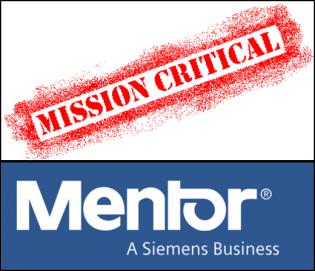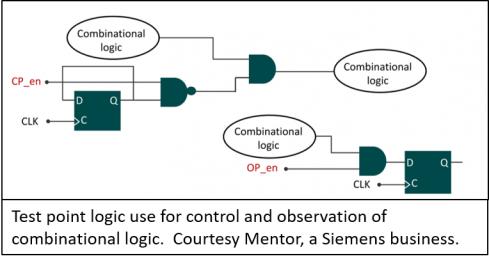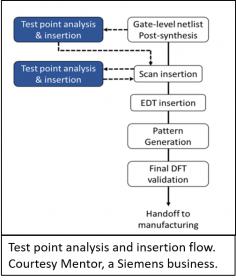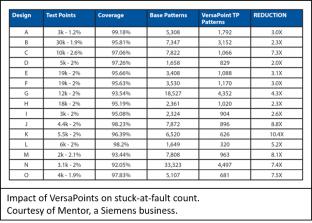 With the advent of the Internet-of-Things (IoT), Industry 4.0, Cognitive Computing, and autonomous vehicles and robots we are seeing an unprecedented number of systems-on-a-chip (SoCs) going into mission-critical applications. To accomplish the complexity of these applications, SoCs are being manufactured in leading-edge processes where manufacturing tolerances are being pushed to their limits. Not only are the devices more complex, but the processes required to manufacture them have more subtle defects mechanisms than in the past. All of this has led to designs with exploding test data volumes and associated testing costs that could threaten their viability.
With the advent of the Internet-of-Things (IoT), Industry 4.0, Cognitive Computing, and autonomous vehicles and robots we are seeing an unprecedented number of systems-on-a-chip (SoCs) going into mission-critical applications. To accomplish the complexity of these applications, SoCs are being manufactured in leading-edge processes where manufacturing tolerances are being pushed to their limits. Not only are the devices more complex, but the processes required to manufacture them have more subtle defects mechanisms than in the past. All of this has led to designs with exploding test data volumes and associated testing costs that could threaten their viability.
The test and electronic design automation (EDA) industries have done a brilliant job so far to keep up with Moore’s Law through the introduction of testing technologies like SCAN synthesis, ATPG, Built-in-Self-Test (BIST), and Embedded Deterministic Test (EDT). EDT has scaled to well beyond the 100X range for data compression, but the demand for more compression continues as test pattern data volumes are driven by more complex design structures, greater combinatorial depth, more complicated clocking schemes, and the use of new fault models appearing at advanced nodes. Mentor, a Siemens business, recently released a new white paper that touches on these points and introduces their next generation of test compression dubbed Tessent VersaPoint Test Point Technology.
 VersaPoint is a hybrid of Mentor’s Tessent TestKompress (TK) and Tessent LogicBIST methodologies that combines EDT and LBIST. EDT provides the high-quality test needed for mission-critical requirements while LBIST is used for in-system testing. Both these technologies (EDT and LBIST) use something known as ‘test points’ to improve the overall testability of a circuit. If you remember back to IC-Test 101, to be able to detect a fault on a given node, you must be able to both control and observe that node. Test points are extra logic inserted into a circuit that lets you do just that. See figure for examples of typical logic used for both control-type and observation-type test points.
VersaPoint is a hybrid of Mentor’s Tessent TestKompress (TK) and Tessent LogicBIST methodologies that combines EDT and LBIST. EDT provides the high-quality test needed for mission-critical requirements while LBIST is used for in-system testing. Both these technologies (EDT and LBIST) use something known as ‘test points’ to improve the overall testability of a circuit. If you remember back to IC-Test 101, to be able to detect a fault on a given node, you must be able to both control and observe that node. Test points are extra logic inserted into a circuit that lets you do just that. See figure for examples of typical logic used for both control-type and observation-type test points.
 Previous to VersaPoint, the insertion of test points for both EDT and LBIST required a two-step process. VersaPoint enables a one-pass process in which test points for both types of tests are added concurrently. Both the analysis the insertion steps for the test points can be performed on a gate-level netlist either before or after scan insertion. While this makes for a simpler test flow, more importantly it also provides for better test compression results.
Previous to VersaPoint, the insertion of test points for both EDT and LBIST required a two-step process. VersaPoint enables a one-pass process in which test points for both types of tests are added concurrently. Both the analysis the insertion steps for the test points can be performed on a gate-level netlist either before or after scan insertion. While this makes for a simpler test flow, more importantly it also provides for better test compression results.
As evidence of the better compression achieved, Mentor added the following table of 15 designs ranging in size from 1.4M gates up to 23.3M gates with an average size of 7.3M gates. The average compression ratio for these designs when using standard EDT methodologies is 46X. However, with the new VersaPoint test points, the average pattern count reduction achieved for these designs is 5.2X vs only 3.9X when using EDT test points. This may not seem like much but when you look at the compression achieved from using the VersaPoint test points you get a whopping 240X compression as compared to a 46X compression from EDT test points alone. That’s a lot!

One key aspect of adding test points is to minimize any negative effects of the test points on circuit timing closure. Mentor has added several features to support this including the ability to exclude test points from any false and multi-cycle paths using a functional SDC file. Test points can also be excluded from critical paths extracted from static timing analysis and the number of control-type test points added to a single path can be limited to a specific value.
While VersaPoint test points give great results for Stuck-At Faults (SAF), they are also effective for all other types of fault models as well. The white paper has tables showing similar if not better results when using VersaPoint test points with Transition Delay Fault (TDF) models. VersaPoint test points also have benefit when used with so-called ‘low-power ATPG’ algorithms that try to reduce switching activity. These low-power ATPG algorithms tend to create higher pattern counts which can be mitigated by using VersaPoint test points.
All in all, the new VersaPoint capability seems impressive and with the new era of Mission-Critical SoCs that are coming to market, it’s good news that Mentor continues to attack the test problem. Making sure SoCs for these types of designs are manufacturing defect free has got to be high on a system design company’s list of priorities, which bodes well for Mentor’s Tessent family of products.
See also:
White Paper: Improving Test Pattern Compression with Tessent VersaPoint Test Point Technology
Mentor Tessent Products web page






Comments
There are no comments yet.
You must register or log in to view/post comments.